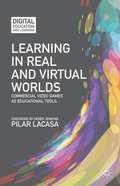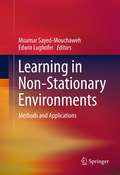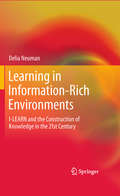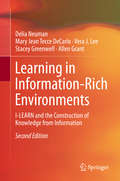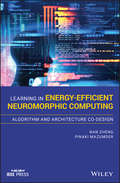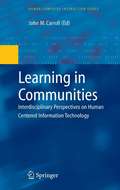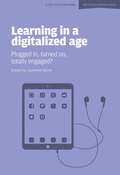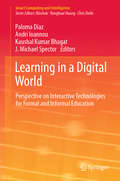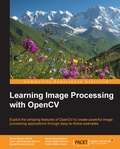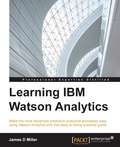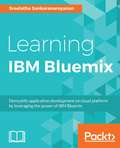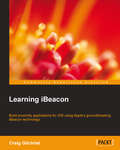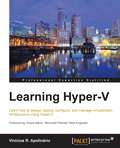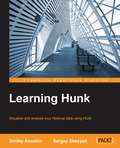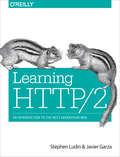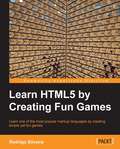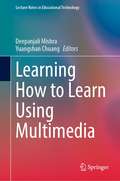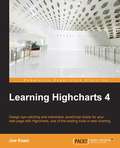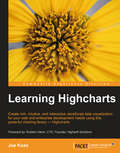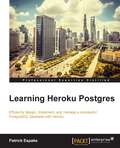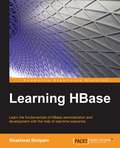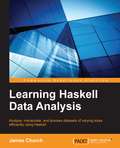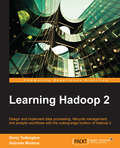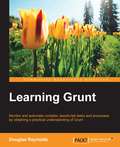- Table View
- List View
Learning In Real And Virtual Worlds
by Pilar LacasaPacked with critical analysis and real-life examples, this book explores how video games can cultivate learning. Lacasa takes several commercial video games and shows how they can be used both in and out of the classroom to teach initiative and problem-solving, encourage creativity, promote literacy, and develop reasoning skills. The result of almost ten years spent discovering video games, learning to play, conversing with their designers and distributors, and working in the classroom with young people and teachers, Lacasa's work uncovers the educational value already present in commercial video games and shows how to integrate games for learning purposes into the curriculum. It is invaluable for anyone wishing to discover the cultural and educational value of this new form of entertainment in an interdisciplinary environment in which psychology, sociology, art, literature, graphic design, and computer programming are all present.
Learning in Non-Stationary Environments
by Moamar Sayed-Mouchaweh Edwin LughoferRecent decades have seen rapid advances in automatization processes, supported by modern machines and computers. The result is significant increases in system complexity and state changes, information sources, the need for faster data handling and the integration of environmental influences. Intelligent systems, equipped with a taxonomy of data-driven system identification and machine learning algorithms, can handle these problems partially. Conventional learning algorithms in a batch off-line setting fail whenever dynamic changes of the process appear due to non-stationary environments and external influences. Learning in Non-Stationary Environments: Methods and Applications offers a wide-ranging, comprehensive review of recent developments and important methodologies in the field. The coverage focuses on dynamic learning in unsupervised problems, dynamic learning in supervised classification and dynamic learning in supervised regression problems. A later section is dedicated to applications in which dynamic learning methods serve as keystones for achieving models with high accuracy. Rather than rely on a mathematical theorem/proof style, the editors highlight numerous figures, tables, examples and applications, together with their explanations. This approach offers a useful basis for further investigation and fresh ideas and motivates and inspires newcomers to explore this promising and still emerging field of research.
Learning in Information-Rich Environments
by Delia NeumanThe amount and range of information available to today's students--and indeed to all learners--is unprecedented. Phrases like "the information revolution", "the information (or knowledge) society", and "the knowledge economy" underscore the truism that our society has been transformed by virtually instantaneous access to virtually unlimited information. Thomas Friedman tells us that "The World Is Flat" and that we must devise new political and economic understandings based on the ceaseless communication of information from all corners of the world. The Bush administration tells us that information relating to the "war on terrorism" is so critical that we must allow new kinds of surveillance to keep society safe. Teenage subscribers to social-computing networks not only access information but enter text and video images and publish them widely--becoming the first adolescents in history to be creators as well as consumers of vast quantities of information. If the characteristics of "the information age" demand new conceptions of commerce, national security, and publishing--among other things--it is logical to assume that they carry implications for education as well. In fact, a good deal has been written over the last several decades about how education as a whole must transform its structure and curriculum to accommodate the possibilities offered by new technologies. Far less has been written, however, about how the specific affordances of these technologies--and the kinds of information they allow students to access and create--relate to the central purpose of education: learning. What does "learning" mean in an information-rich environment? What are its characteristics? What kinds of tasks should it involve? What concepts, strategies, attitudes, and skills do educators and students need to master if they are to learn effectively and efficiently in such an environment? How can researchers, theorists, and practitioners foster the well-founded and widespread development of such key elements of the learning process? This book explores these questions and suggests some tentative answers. Drawing from research and theory in three distinct but related fields--learning theory, instructional systems design, and information studies--it presents a way to think about learning that responds directly to the actualities of a world brimming with information. The book is grounded in the work of such key figures in learning theory as Bransford and Anderson & Krathwohl. It draws on such theorists of instructional design as Gagne, Mayer, and Merrill. From information studies, it uses ideas from Buckland, Marchionini, and Wilson (who is known for his pioneering work in "information behavior"--that is, the full range of information seeking and use). The book breaks new ground in bringing together ideas that have run in parallel for years but whose relationship has not been fully explored.
Learning in Information-Rich Environments: I-LEARN and the Construction of Knowledge from Information
by Delia Neuman Mary Jean Tecce DeCarlo Vera J. Lee Stacey Greenwell Allen GrantThe amount and range of information available to today’s students—and indeed to all learners—is unprecedented. If the characteristics of “the information age” demand new conceptions of commerce, national security, and publishing—among other things—it is logical to assume that they carry implications for education as well. Little has been written, however, about how the specific affordances of these technologies—and the kinds of information they allow students to access and create—relate to the central purpose of education: learning. What does “learning” mean in an information-rich environment? What are its characteristics? What kinds of tasks should it involve? What concepts, strategies, attitudes, and skills do educators and students need to master if they are to learn effectively and efficiently in such an environment? How can researchers, theorists, and practitioners foster the well-founded and widespread development of such key elements of the learning process? This second edition continues these discussions and suggests some tentative answers. Drawing primarily from research and theory in three distinct but related fields—learning theory, instructional systems design, and information studies—it presents a way to think about learning that responds directly to the actualities of a world brimming with information. The second edition also includes insights from digital and critical literacies and provides a combination of an updated research-and-theory base and a collection of instructional scenarios for helping teachers and librarians implement each step of the I-LEARN model. The book could be used in courses in teacher preparation, academic-librarian preparation, and school-librarian preparation.
Learning in Energy-Efficient Neuromorphic Computing: Algorithm And Architecture Co-design (Wiley - IEEE)
by Nan Zheng Pinaki MazumderExplains current co-design and co-optimization methodologies for building hardware neural networks and algorithms for machine learning applications This book focuses on how to build energy-efficient hardware for neural networks with learning capabilities—and provides co-design and co-optimization methodologies for building hardware neural networks that can learn. Presenting a complete picture from high-level algorithm to low-level implementation details, Learning in Energy-Efficient Neuromorphic Computing: Algorithm and Architecture Co-Design also covers many fundamentals and essentials in neural networks (e.g., deep learning), as well as hardware implementation of neural networks. The book begins with an overview of neural networks. It then discusses algorithms for utilizing and training rate-based artificial neural networks. Next comes an introduction to various options for executing neural networks, ranging from general-purpose processors to specialized hardware, from digital accelerator to analog accelerator. A design example on building energy-efficient accelerator for adaptive dynamic programming with neural networks is also presented. An examination of fundamental concepts and popular learning algorithms for spiking neural networks follows that, along with a look at the hardware for spiking neural networks. Then comes a chapter offering readers three design examples (two of which are based on conventional CMOS, and one on emerging nanotechnology) to implement the learning algorithm found in the previous chapter. The book concludes with an outlook on the future of neural network hardware. Includes cross-layer survey of hardware accelerators for neuromorphic algorithms Covers the co-design of architecture and algorithms with emerging devices for much-improved computing efficiency Focuses on the co-design of algorithms and hardware, which is especially critical for using emerging devices, such as traditional memristors or diffusive memristors, for neuromorphic computing Learning in Energy-Efficient Neuromorphic Computing: Algorithm and Architecture Co-Design is an ideal resource for researchers, scientists, software engineers, and hardware engineers dealing with the ever-increasing requirement on power consumption and response time. It is also excellent for teaching and training undergraduate and graduate students about the latest generation neural networks with powerful learning capabilities.
Learning in Communities
by John M. CarrollMost learning takes place in communities. People continually learn through their participation with others in everyday activities. Such learning is important in contemporary society because formal education cannot prepare people for a world that changes rapidly and continually. We need to live in learning communities. This volume gathers together all of the scholarly materials directly emanating from a workshop held in August 2005, when a multidisciplinary group of scholars met at Penn State's College of Information Sciences and Technology to discuss 'learning in communities'. Initially, a sectioned report on the workshop was published as a special section in the Journal of Community Informatics in 2006. Subsequently, a special issue of 5 full papers was published in the Journal of Computer-Supported Cooperative Work, and a special section of 2 full papers was published in the International Journal of Computer-Supported Collaborative Learning.
Learning in a Digitalized Age: Plugged in, Turned on, Totally Engaged? (World Class Schools Ser.)
by Lawrence BurkeAll professional learning communities agree that there is added value in utilizing technologies to enhance and facilitate student success. This volume seeks from us a critical and informed answer to one of the most important educational questions of the day: how successful will learners be in the digital age? Here, writers with real hands-on experience in the field challenge many of the assumptions about teaching and learning in the digital age. It is relevant and important for all those interested and concerned about the kinds of debates, arguments and ideas which are influencing and changing the nature of teaching and learning in the early decades of the 21st century.
Learning in a Digitalized Age: Plugged in, Turned on, Totally Engaged? (World Class Schools Ser.)
by Lawrence BurkeAll professional learning communities agree that there is added value in utilizing technologies to enhance and facilitate student success. This volume seeks from us a critical and informed answer to one of the most important educational questions of the day: how successful will learners be in the digital age? Here, writers with real hands-on experience in the field challenge many of the assumptions about teaching and learning in the digital age. It is relevant and important for all those interested and concerned about the kinds of debates, arguments and ideas which are influencing and changing the nature of teaching and learning in the early decades of the 21st century.
Learning in a Digital World: Perspective on Interactive Technologies for Formal and Informal Education (Smart Computing and Intelligence)
by Paloma Díaz Andri Ioannou Kaushal Kumar Bhagat J. Michael SpectorThis book aims at guiding the educators from a variety of available technologies to support learning and teaching by discussing the learning benefits and the challenges that interactive technology imposes. This guidance is based on practical experiences gathered through developing and integrating them into varied educational settings. It compiles experiences gained with various interactive technologies, offering a comprehensive perspective on the use and potential value of interactive technologies to support learning and teaching. Taken together, the chapters provide a broader view that does not focus exclusively on the uses of technology in educational settings, but also on the impact and ability of technology to improve the learning and teaching processes.The book addresses the needs of researchers, educators and other stakeholders in the area of education interested in learning how interactive technologies can be used to overcome key educational challenges.
Learning Image Processing with OpenCV
by Gloria Bueno Garcia Oscar Deniz SuarezIf you are a competent C++ programmer and want to learn the tricks of image processing with OpenCV, then this book is for you. A basic understanding of image processing is required.
Learning IBM Watson Analytics
by James D MillerMake the most advanced predictive analytical processes easy using Watson Analytics with this easy-to-follow practical guide About This Book * This is the first and the only book on IBM Watson Analytics, and it shows you how to leverage Watson in an enterprise environment through rich use cases * Incorporate Watson Analytics into your business strategy and confidently add this cutting edge expertise to your resume * This book is written by James D Miller, IBM-certified expert and accomplished Director and Sr. Project Leader Who This Book Is For If you want to perform data discovery and analysis and make sense of data you have, this book for you. Data scientists can also use this book to explore a new way to perform data analysis tasks on cloud with ease. This book does not require a programming background. What You Will Learn * Study the language of Watson while you discover how easy it is to access and configure * Review what a Watson use case is, why it's important, and how to identify one * Design Watson Analytical solutions based upon your use cases * Understand the basic concepts behind the content analysis cycle and where Watson fits in * Explore all the features of Watson, such as Explore, Predict, and Assemble * Customize and extend your Watson solutions * Use Watson at the Enterprise level * Integrate Watson with other toolsets In Detail Today, only a small portion of businesses actually use a real analytical tool as part of routine decision making. IBM Watson Analytics is changing that making the most advanced and predictive analytical techniques understandable and usable for any industry. This book will be the vital tour guide for your trip, starting with what IBM Watson Analytics is. We'll start off with introduction to Watson Analytics and then quickly move on to various use cases under which one can use the different analytics functionalities offered by Watson. During the course of the book, you will learn how to design solutions, and customize and extend Watson analytics. We will conclude by taking Watson Analytics to enterprise and integrating it with other solutions (other IBM solutions and analytics). Now is the time for you to learn IBM Watson to compete in the world. Style and approach Watson provides individuals with the ability to perform sophisticated data discovery and analysis without all of the complexity that usually goes along with it. This book will get you started with Watson analytics and how you can use it in day-to-day data analysis. The book introduces the key concepts and terminology and then uses practical use case examples to reinforce your understanding.
Learning IBM Bluemix
by Sreelatha SankaranarayananDemystify application development on cloud platform by leveraging the power of IBM Bluemix About This Book * The first book in the market that discusses the power of IBM Bluemix * Shows developers how to develop and deploy applications on the cloud platform using IBM Bluemix * A comprehensive guide to help you get started with IBM Bluemix also featuring samples applications Who This Book Is For This book is aimed at developers seeking to learn application development and deployment methods on IBM Bluemix. A basic knowledge of Java and Node.js is assumed. What You Will Learn * Discover IBM Bluemix as a PaaS platform and learn about its three delivery models * Develop and deploy a "Hello World" application on IBM Bluemix using the Cloud Foundry command line utility and the Bluemix console * Extend your application by using the API or services provided by IBM Bluemix * Understand microservices architecture and learn how to develop a sample application based on microservices architecture, using IBM Bluemix * Learn how to leverage on-premise software and build an application on IBM Bluemix * Scale and monitor an application on IBM Bluemix * Explore the compute options on IBM Bluemix and work with each of them * Build a mobile client application using Mobile services on IBM Bluemix In Detail IBM Bluemix is an open standard platform for building, running, and managing applications on the cloud. With Bluemix, developers can build innovative applications using various compute options and value added services , developers can also manage the application lifecycle using the platform provided DevOps services. Learning IBM Bluemix will take you on a journey from the basics of IBM Bluemix to working with the platform to developing and deploying of modern applications. The sample application use cases employed in the book will introduce you to the transformative nexus of cloud, mobile, and security, all enabled through capabilities provided out-of-the-box by IBM Bluemix. By the end of the book, you will have understood the benefits and use cases for IBM Bluemix, and will possess the skills to further explore the platform and thus develop, deploy, and secure your own innovative, new-age applications. Style and approach This comprehensive, step-by-step guide to learning IBM Bluemix will cover everything that is required to build, deploy, manage, and secure an application on the cloud.
Learning iBeacon
by Craig GilchristThis book is intended for iOS developers who are curious to learn about iBeacon and want to start building applications for iOS. You will gain everything you need to know to master indoor location functionality using Bluetooth beacon technology. No knowledge of iBeacon is assumed.
Learning Hyper-V
by Vinicius R. ApolinarioThis book focuses on readers starting their journey with Hyper-V, and assumes they have minimal or no knowledge of virtualization.
Learning Hunk
by Sergey Sheypak Dmitry AnoshinVisualize and analyze your Hadoop data using Hunk About This Book * Explore your data in Hadoop and NoSQL data stores * Create and optimize your reporting experience with advanced data visualizations and data analytics * A comprehensive developer's guide that helps you create outstanding analytical solutions efficiently Who This Book Is For If you are Hadoop developers who want to build efficient real-time Operation Intelligence Solutions based on Hadoop deployments or various NoSQL data stores using Hunk, this book is for you. Some familiarity with Splunk is assumed. What You Will Learn * Deploy and configure Hunk on top of Cloudera Hadoop * Create and configure Virtual Indexes for datasets * Make your data presentable using the wide variety of data visualization components and knowledge objects * Design a data model using Hunk best practices * Add more flexibility to your analytics solution via extended SDK and custom visualizations * Discover data using MongoDB as a data source * Integrate Hunk with AWS Elastic MapReduce to improve scalability In Detail Hunk is the big data analytics platform that lets you rapidly explore, analyse, and visualize data in Hadoop and NoSQL data stores. It provides a single, fluid user experience, designed to show you insights from your big data without the need for specialized skills, fixed schemas, or months of development. Hunk goes beyond typical data analysis methods and gives you the power to rapidly detect patterns and find anomalies across petabytes of raw data. This book focuses on exploring, analysing, and visualizing big data in Hadoop and NoSQL data stores with this powerful full-featured big data analytics platform. You will begin by learning the Hunk architecture and Hunk Virtual Index before moving on to how to easily analyze and visualize data using Splunk Search Language (SPL). Next you will meet Hunk Apps which can easy integrate with NoSQL data stores such as MongoDB or Sqqrl. You will also discover Hunk knowledge objects, build a semantic layer on top of Hadoop, and explore data using the friendly user-interface of Hunk Pivot. You will connect MongoDB and explore data in the data store. Finally, you will go through report acceleration techniques and analyze data in the AWS Cloud. Style and approach A step-by-step guide starting right from the basics and deep diving into the more advanced and technical aspects of Hunk.
Learning HTTP/2: A Practical Guide for Beginners
by Javier Garza Stephen LudinWhat can your organization gain by adopting HTTP/2? How about faster, simpler, and more robust websites and applications? This practical guide demonstrates how the latest version of the Hypertext Transfer Protocol can dramatically improve website and application performance. You’ll take a deep dive into HTTP/2 details, and learn how this updated protocol is changing the web landscape.HTTP/1.1 has been the primary means of communicating data across the web for the past 20 years, but the level of interaction today has gone well beyond what people envisioned in 1997. With this book, authors Stephen Ludin and Javier Garza show you how HTTP/2 will help speed the execution of modern sites and applications.With this book, you’ll explore:Performance challenges that led to the HTTP upgradeHTTP/2 in a nutshell, including benefits and transition methodsExisting best practices and hacks to improve web performanceHTTP/2 support for browsers, servers, proxies, and content delivery networksHow the performance of sites using HTTP/2 compares to their HTTP/1.1 experienceHTTP/2’s effect on specific issues such as latency, packet loss, and Time to First Byte (TTFB)HTTP/2’s effect on specific issues such as latency, packet loss, and Time to First Byte (TTFB)
Learning HTML5 by Creating Fun Games
by Rodrigo SilveiraBy teaching HTML5 by developing exciting games, the reader will see concrete applications for each of the concepts, and will also have a powerful deliverable at the end of each chapter - a fully functional game. We learn the various concepts using very abstract examples - how to model animals, foods, or fictitious machines. This makes learning and understanding a lot easier, and much more enjoyable.If you are are looking to get a good grounding in how to use the new awesome technology that is HTML5, this book is for you. Basic knowledge of HTML and/or HTML5 is welcome, but optional. The book is a friendly and exciting reference for beginners.
Learning How to Learn Using Multimedia (Lecture Notes in Educational Technology)
by Deepanjali Mishra Yuangshan ChuangThis book introduces the concept of multimedia in education, and how multimedia technology could be implemented to impart digital education to university students. The book emphasizes the versatile use of technology enabled education through the research papers from distinguished academicians and researchers who are specifically working in this area. It benefits all those researchers who are enthusiastic about learning online and also for those academicians who are interested to work on various aspects of learning and teaching through technology.
Learning Highcharts
by Joe KuanA complete practical and comprehensive tutorial with clear and step-by-step instructions along with many examples. It's packed with examples, code samples and practical tips in a no-nonsense way. This book is both for beginners and advanced web developers who need to create interactive charts for their web applications. It primarily targets JavaScript Web developers who want to use the Highcharts library to prepare interactive and professional-quality charts and graphs for their applications quickly and easily. Prior experience with JavaScript is assumed.
Learning Highcharts
by Joe KuanA complete practical and comprehensive tutorial with clear and step-by-step instructions along with many examples. It's packed with examples, code samples and practical tips in a no-nonsense way. This book is both for beginners and advanced web developers who need to create interactive charts for their web applications. It primarily targets JavaScript Web developers who want to use the Highcharts library to prepare interactive and professional-quality charts and graphs for their applications quickly and easily. Prior experience with JavaScript is assumed.
Learning Heroku Postgres
by Patrick EspakeLearning Heroku Postgres is targeted at developers and database admins. Even if you're new to Heroku Postgres, you'll be able to master both the basic as well as advanced features of Heroku Postgres. Since Heroku Postgres is incredibly user-friendly, no previous experience in computer coding or programming is required.
Learning HBase
by Shashwat ShriparvIf you are an administrator or developer who wants to enter the world of Big Data and BigTables and would like to learn about HBase, this is the book for you.
Learning Haskell Data Analysis
by James ChurchIf you are a developer, analyst, or data scientist who wants to learn data analysis methods using Haskell and its libraries, then this book is for you. Prior experience with Haskell and a basic knowledge of data science will be beneficial.
Learning Hadoop 2
by Garry Turkington Gabriele ModenaIf you are a system or application developer interested in learning how to solve practical problems using the Hadoop framework, then this book is ideal for you. You are expected to be familiar with the Unix/Linux command-line interface and have some experience with the Java programming language. Familiarity with Hadoop would be a plus.
Learning Grunt
by Douglas ReynoldsMonitor and automate complex JavaScript tasks and processes by obtaining a practical understanding of Grunt About This Book * Gain a solid knowledge of Grunt to achieve better process management by improving consistency, productivity, reliability, and quality of code * Install, configure, and use plugins into your project with this hands-on guide * This step-by-step tutorial will walk you through practical examples of workflow automation Who This Book Is For If you are a JavaScript developer and want to learn project monitoring and automation using Grunt, then this book is for you. Basic knowledge of Node.js and Angular.js is assumed. However, no previous experience using Grunt.js is required. What You Will Learn * Install and configure Grunt and its dependencies such as Node.js and Node Package Manager (NPM) * Create a sample application using Angular.JS * Configure plugins to perform various tasks that will benefit your project * Explore the task-specific methods available through the Grunt API such as configuration, externals, events, and logging * Set up tasks to automate the build process of the simple contact application * Build, test, and refine a sample project * Get general tips, tricks, and troubleshooting strategies to identify and solve common issues in Grunt * Advance your knowledge of Grunt with concepts such as configuration variables and test automation In Detail With the increasing focus on task automation, the Grunt task runner is a vast platform that allows you to incorporate automation into your workflows. At the outset, you will learn how to use Node.js and NMP through an example. You will then find out how to build a sample app and the development environment for it. You will further delve into the implementation of Grunt plugins and the configuration of Grunt tasks. Furthermore, you will explore the various methods and packages for workflow automation. The final chapter will cover some advanced concepts, such as configuration variables and how to create a Grunt plugin. By the end of the book, you will have gained the fundamentals of Grunt and progressed through advanced concepts, including building a Grunt plugin. Style and approach This book is an easy-to-follow, step-by-step tutorial that provides explanations and examples of deploying Grunt from scratch.
